Susceptibility to Expansive Reactions of a Greener UHPC: Micro to Macro-Scale Study
Abstract
:1. Introduction
Research Significance and Objectives
2. Materials and Methods
2.1. Raw Materials and Mix Design
2.2. Experimental Tests Procedures
2.2.1. Porosity
2.2.2. Resistance to ASR
2.2.3. Resistance to External Sulphates
2.2.4. SEM
3. Results and Discussion
3.1. Porosity and Microstructure
3.2. ASR
3.3. External Sulphates Attack
4. Conclusions and Final Remarks
- UHPC presented very low porosity (4.8%), with no capillary pores, and the average pore size diameter was 8.8 nm;
- The ASR test revealed the extraordinary resistance of UHPC (no expansion) against very harsh rich alkalis conditions during 14 days of the standard ASTM 1260 test;
- The ASR test was extended until the UHPC specimens reached 0.1%, which took half a year;
- After half a year of immersion in harsh rich alkalis conditions, the specimens did not present visual damage; however, the ASR gel was found by SEM observations;
- The external sulphates also seemed not to be a concern in UHPC since after 26 weeks of immersion in sodium sulphate solution, specimens did not present expansion or damage;
- Even though UHPC specimens did not expand or present visual damage, ettringite was found by SEM observations.
Funding
Institutional Review Board Statement
Informed Consent Statement
Acknowledgments
Conflicts of Interest
Abbreviations
| ASR | Alkali silica reaction |
| Ca(OH)2 | Calcium hydroxide |
| CSH | Calcium silicate hydrate |
| ECat | Spent equilibrium catalyst |
| HPC | High-performance concretes |
| LF | Limestone filler |
| MIP | Mercury intrusion porosimetry |
| Na2Oeq | Equivalent alkali content (%) |
| NaOH | Sodium Hydroxide |
| OC | Ordinary concrete |
| PC | Portland cement |
| RH | Relative humidity (%) |
| SCM | Supplementary cementitious materials |
| SF | Silica fume |
| Sp | Superplasticizer |
| t | Time (day) |
| T | Temperature (°C) |
| UHPC | Ultra-high-performance cement-based composites |
| UHPFRC | Ultra-high-performance fiber-reinforced cement-based composites |
| w/c | Water to cement weight ratio |
| w/b | Water to binder weight ratio |
Appendix A
| Ductal® | BSI/Ceracem® | CRC® | Cor Tuf® | CEMTECmultiscale® | CARDIF® | BCV® | DUCAN® | DURA® | ||||||||
|---|---|---|---|---|---|---|---|---|---|---|---|---|---|---|---|---|
| Country | France | France | Denmark | USa | France | Wales | France | Germany | Malasya | |||||||
| Year | 1990’s | 1990’s | 1995 | 2001 | 2004 | 1998 | 2004 | 2006 | ||||||||
| Constituent kg/m3 | Type | Type | Type | Type | Type | Type | Type | |||||||||
| Cement | Portland | 746 | 1114 | Binder | 930 | CEM I 52.5 | 1050 | 885 | 2115 premix | |||||||
| Silica fume | 242 | 169 | Binder 1555 | 275 | ||||||||||||
| Quartz flour | 224 | 885 | ||||||||||||||
| Sand (mm) | 0.1−0.6 | 1066 | 0−6 | 1072 | 0−5 | 1325 | 1300 | <0.5 | 730 | 0.009–0.6 | 940 | |||||
| Water | w/c | 0.19 | w/c | 0.19 | w/b | 0.16 | w/b 0.16 | w/c | 0.18 | w/c | 0.22 | w/c | 0.25 | |||
| Admixture | Chryso | 9 | SIKA | 10 | Chryso | 35 | 21.5 | |||||||||
| Fiber (l/d) | 13/0.2 | 161 | 20/0.3 | 234 | 12/0.4 | 150–300 | 150–300 | 10/0.2 | 470 | 468 | 156 | Vol% | 3–7% | |||
| Slump flow (mm) | 700 | 640 | 750 | |||||||||||||
| fct, 28 (MPa) | 8 | 8.8 | 90 °C | 30 | 8–10 | 8–20 | 6–10 | |||||||||
| fcm, 7 (MPa) | 20 °C | 101 | 20 °C | 165 | 20 °C | 98 | ||||||||||
| fcm, 28 (MPa) | 20 °C/90 °C | 124/198 | 20 °C | 199 | 20 °C/90 °C | 150/400 | 20 °C | 168 | 90 °C | 207 | 20 °C/90 °C | 130/200 | 90–200 | 130–170 | ||
References
- Hewlett, P. Lea’s Chemistry of Cement and Concrete, 4th ed.; Elsevier Science & Technology Books: Amsterdam, The Netherlands, 2004. [Google Scholar] [CrossRef]
- Richard, P.; Cheyrezy, M. Composition of reactive powder concretes. Cem. Concr. Res. 1995, 25, 1501–1511. [Google Scholar] [CrossRef]
- Fehling, E.; Schmidt, M.; Walraven, J.; Leutbecher, T.; Frohlich, S. Ultra-High Performance Concrete UHPC: Fundamentals, Design, Examples; Ernst & Sohn, Wiley: Berlin, Germany, 2014. [Google Scholar] [CrossRef]
- Graybeal, B.; Brühwiler, E.; Kim, B.-S.; Toutlemonde, F.; Voo, Y.L.; Zaghi, A. International Perspective on UHPC in Bridge Engineering. J. Bridge Eng. 2020, 25, 04020094. [Google Scholar] [CrossRef]
- Tayeh, B.A.; Bakar, B.H.A.; Johari, M.A.M.; Voo, Y.L. Evaluation of Bond Strength between Normal Concrete Substrate and Ultra High Performance Fiber Concrete as a Repair Material. Procedia Eng. 2013, 54, 554–563. [Google Scholar] [CrossRef] [Green Version]
- Nematollahi, B.; Raizal Saifulnaz, M.R.; Voo, Y.L. Sustainability assessment of precast ultra-high performance fiber reinforced concrete (UHPFRC) cantilever retaining walls. Res. J. Appl. Sci. Eng. Technol. 2014, 7, 3971–3977. Available online: http://www.scopus.com/inward/record.url?eid=2-s2.0-84901989877&partnerID=tZOtx3y1 (accessed on 23 May 2022). [CrossRef]
- Tayeh, B.A.; Bakar, B.H.A.; Johari, M.A.M.; Voo, Y.L. Utilisation of Ultra-high Performance Fibre Concrete (UHPFC) for Rehabilitation—A Review. Procedia Eng. 2013, 54, 525–538. [Google Scholar] [CrossRef] [Green Version]
- Li, V.C. Complete characterisation of tensile properties of Ductal® UHPFRC according to the French recommendations. In Proceedings of the International Workshop High Performance Fiber Reinforced Cement Composites, Ann Arbor, MI, USA, 16–18 June 2003; Volume 1, pp. 21–34. [Google Scholar]
- Wille, K.; Kim, D.J.; Naaman, A.E. Strain-hardening UHP-FRC with low fiber contents. Mater. Struct./Mater. Constr. 2011, 44, 583–598. [Google Scholar] [CrossRef]
- Graybeal, B.A.; Russel, H.G. Ultra-High Performance Concrete: A State-of-the-Art Report for the Bridge Community; Publication No. FHWA-HRT-13-060; Federal Highway Administration: Washington, DC, USA, 2013. [Google Scholar]
- McDonagh, M.D.; Foden, A.J.; Brinckerhoff Andrew Foden, P.J.; Brinckerhoff, P. Benefits of Ultra-High Performance Concrete for the Rehabilitation of the Pulaski Skyway. In Proceedings of the First International Interactive Symposium on UHPC, Des Moines, IA, USA, 18–20 July 2016. [Google Scholar]
- Zmetra, K.; Zaghi, A.E.; Wille, K. Rehabilitation of Steel Bridge Girders with Corroded Ends Using Ultra-High Performance Concrete. In Proceedings of the 2015 Structures Congress, Portland, Oregon, 23–25 April 2015; pp. 1411–1422. [Google Scholar] [CrossRef]
- Graybeal, B. Construction of Field-Cast Ultra-High Performance Concrete Connections, April 2012—FHWA-HRT-12-038. 2012. Available online: https://www.fhwa.dot.gov/publications/research/infrastructure/structures/bridge/12038/index.cfm (accessed on 17 May 2022).
- Competitive and Sustainable Growth (GROWTH) Programme. SAMARIS Sustainable and Advanced MAterials for Road InfraStructure WP 14: HPFRCC (High Performance Fibre Reinforced Cementitious Composites) for Rehabilitation Deliverable D25b Guidelines for the Use of UHPFRC for Rehabilitation of Concrete Highway Structures; Competitive and Sustainable Growth (GROWTH) Programme: Delft, The Netherlands, 2006. [Google Scholar]
- Brühwiler, E.; Denarié, E. Rehabilitation of concrete structures using Ultra-High Performance Fibre Reinforced Concrete. In Proceedings of the UHPC-2008: The Second International Symposium on Ultra High Performance Concrete, Kassel, Germany, 5–7 March 2008; pp. 1–8. [Google Scholar]
- Bruhwiler, E.; Denarie, E. Rehabilitation and Strengthening of Concrete Structures Using Ultra-High Performance Fibre Reinforced Concrete. Struct. Eng. Int. 2013, 23, 450–457. [Google Scholar] [CrossRef]
- Denarié, E.; Brühwiler, E. Cast-on site UHPFRC for improvement of existing structures—Achievements over the last 10 years in practice and research. In Proceedings of the HPFRCC7: 7th Workshop on High Performance Fiber Reinforced Cement Composites, Stuttgart, Germany, 1–3 June 2015. [Google Scholar]
- Denarié, E.; Brühwiler, E. Structural Rehabilitations with Ultra-High Performance Fibre Reinforced Concretes (UHPFRC)/Strukturelle Instandsetzung von Betonbrücken mit Ultra-hochleistungsfähigem Faserfeinkornbeton (UHFB). Restor. Build. Monum. 2006, 12, 93–108. [Google Scholar] [CrossRef]
- Nabaei, S.; Nendaz, S. Rehabilitation of transportation infrastructures: The potential of new materials. In Proceedings of the IABSE Conference: Structural Engineering: Providing Solutions to Global Challenges, Geneva, Switzerland, 23–25 September 2015. [Google Scholar]
- Brühwiler, E.; Bastien Masse, M. Strengthening the Chillon viaducts deck slabs with reinforced UHPFRC. In Proceedings of the IABSE Conference Geneva 2015—Structural Engineering: Providing Solutions to Global Challenges, Geneva, Switzerland, 23–25 September 2015. [Google Scholar]
- Nazar, S.; Ismaiel, M.A.; Ahmed, M. Possibility to Improve Strength and Structural Stability of Bridge Deck Slabs by Using Ultra High Performance Fiber Reinforced Concrete. IOSR J. Mech. Civ. Eng. 2014, 11, 79–87. [Google Scholar]
- Wang, W.; Liu, J.; Agostini, F.; Davy, C.A.; Skoczylas, F.; Corvez, D. Durability of an Ultra High Performance Fiber Reinforced Concrete (UHPFRC) under progressive aging. Cem. Concr. Res. 2014, 55, 1–13. [Google Scholar] [CrossRef]
- Heinz, D.; Dehn, F.; Urbonas, L. Fire Resistance of Ultra High Perfoemance Concrete (UHPC)—Testing of Laboratory Samples and Column under Load. In Proceedings of the International Symposium on Ultra High Performance Concrete, Kassel, Germany, 13–15 September 2004. [Google Scholar]
- Herold, G.; Müller, H.S. Measurement of porosity of ultra high strength fiber reinforced concrete. In Proceedings of the International Symposium on Ultra High Performance Concrete, Kassel, Germany, 13–15 September 2004; pp. 685–694. [Google Scholar]
- Roux, N.; Andrade, C.; Sanjuan, M.A. Experimental Study of Durability of Reactive Powder Concretes. J. Mater. Civ. Eng. 1996, 8, 1–6. [Google Scholar] [CrossRef]
- Wang, D.; Shi, C.; Wu, Z.; Xiao, J.; Huang, Z.; Fang, Z. A review on ultra high performance concrete: Part II. Hydration, microstructure and properties. Constr. Build. Mater. 2015, 96, 368–377. [Google Scholar] [CrossRef]
- Li, J.; Wu, Z.; Shi, C.; Yuan, Q.; Zhang, Z. Durability of ultra-high performance concrete—A review. Constr. Build. Mater. 2020, 255, 119296. [Google Scholar] [CrossRef]
- Cheyrezy, M.; Maret, V.; Frouin, L.; Bouygues, D.S.; Quentin, S. Microstructural analysis of RPC (Reactive Powder Concrete). Cem. Concr. Res. 1995, 25, 1491–1500. [Google Scholar] [CrossRef]
- Matos, A.M.; Nunes, S.; Costa, C.; Aguiar, J.L.B. Durability of an UHPC containing spent equilibrium catalyst. Constr. Build. Mater. 2021, 305, 124681. [Google Scholar] [CrossRef]
- Wille, K.; Naaman, A.E.; El-Tawil, S.; Parra-Montesinos, G.J. Ultra-high performance concrete and fiber reinforced concrete: Achieving strength and ductility without heat curing. Mater. Struct. 2012, 45, 309–324. [Google Scholar] [CrossRef]
- Moser, B.; Pfeifer, C. Microstructure and Durability of Ultra-High Performance Concrete. In Proceedings of the UHPC-2008: The Second International Symposium on Ultra High Performance Concrete, Kassel, Germany, 5–7 March 2008. [Google Scholar]
- Graybeal, B.; Tanesi, J. Durability of an Ultrahigh-Performance Concrete. J. Mater. Civ. Eng. 2007, 19, 848–854. [Google Scholar] [CrossRef]
- Odler, I.; Rößler, M. Investigations on the relationship between porosity, structure and strength of hydrated Portland cement pastes. II. Effect of pore structure and of degree of hydration. Cem. Concr. Res. 1985, 15, 401–410. [Google Scholar] [CrossRef]
- Yazici, H.; Yardımcı, M.Y.; Aydin, S.; Karabulut, A.S. Mechanical properties of reactive powder concrete containing mineral admixtures under different curing regimes. Constr. Build. Mater. 2009, 23, 1223–1231. [Google Scholar] [CrossRef]
- Yazıcı, H.; Yardımcı, M.Y.; Yigiter, H.; Aydın, S.; Turkel, S. Mechanical properties of reactive powder concrete containing high volumes of ground granulated blast furnace slag. Cem. Concr. Compos. 2010, 32, 639–648. [Google Scholar] [CrossRef]
- Huang, W.; Kazemi-Kamyab, H.; Sun, W.; Scrivener, K. Effect of cement substitution by limestone on the hydration and microstructural development of ultra-high performance concrete (UHPC). Cem. Concr. Compos. 2017, 77, 86–101. [Google Scholar] [CrossRef]
- Yu, R.; Spiesz, P.; Brouwers, H.J.H. Development of an eco-friendly Ultra-High Performance Concrete (UHPC) with efficient cement and mineral admixtures uses. Cem. Concr. Compos. 2015, 55, 383–394. [Google Scholar] [CrossRef] [Green Version]
- Pyo, S.; Kim, H.K. Fresh and hardened properties of ultra-high performance concrete incorporating coal bottom ash and slag powder. Constr. Build. Mater. 2017, 131, 459–466. [Google Scholar] [CrossRef]
- Rajasekar, A.; Arunachalam, K.; Kottaisamy, M.; Saraswathy, V. Durability characteristics of Ultra High Strength Concrete with treated sugarcane bagasse ash. Constr. Build. Mater. 2018, 171, 350–356. [Google Scholar] [CrossRef]
- Vaitkevičius, V.; Šerelis, E.; Hilbig, H. The effect of glass powder on the microstructure of ultra high performance concrete. Constr. Build. Mater. 2014, 68, 102–109. [Google Scholar] [CrossRef]
- Soliman, N.A.; Tagnit-Hamou, A. Partial substitution of silica fume with fine glass powder in UHPC: Filling the micro gap. Constr. Build. Mater. 2017, 139, 374–383. [Google Scholar] [CrossRef]
- Van Tuan, N.; Ye, G.; Van Breugel, K.; Fraaij, A.L.A.; Bui, D.D. The study of using rice husk ash to produce ultra high performance concrete. Constr. Build. Mater. 2011, 25, 2030–2035. [Google Scholar] [CrossRef]
- Van, V.T.A.; Rößler, C.C.; Bui, D.D.; Ludwig, H.M. Rice husk ash as both pozzolanic admixture and internal curing agent in ultra-high performance concrete. Cem. Concr. Compos. 2014, 53, 270–278. [Google Scholar] [CrossRef]
- Latifee, E. Miniature Concrete Prism Test—A New Test Method For Evaluating the ASR Potential of Aggregates, the Effectiveness of ASR Mitigation and the Job Mixture. Ph.D. Thesis, Clemson University, Clemson, SC, USA, 2013. [Google Scholar]
- Sims, I.; Poole, A.B. (Eds.) Alkali-Aggregate Reaction in Concrete: A World Review; CRC Press: Boca Raton, FL, USA, 2017. [Google Scholar]
- Mohammadi, A.; Ghiasvand, E.; Nili, M. Relation between mechanical properties of concrete and alkali-silica reaction (ASR)—A review. Constr. Build. Mater. 2020, 258, 119567. [Google Scholar] [CrossRef]
- Thomas, M.D.A.; Fournier, B.; Folliard, K.J. Alkali-Aggregate Reactivity (AAR) Facts Book; US Department of Transportation: Washington, DC, USA, 2013. [Google Scholar]
- Fanijo, E.O.; Kolawole, J.T.; Almakrab, A. Alkali-silica reaction (ASR) in concrete structures: Mechanisms, effects and evaluation test methods adopted in the United States. Case Stud. Constr. Mater. 2021, 15, e00563. [Google Scholar] [CrossRef]
- Cao, J.; Gowripalan, N.; Sirivivatnanon, V.; South, W. Accelerated test for assessing the potential risk of alkali-silica reaction in concrete using an autoclave. Constr. Build. Mater. 2021, 271, 121871. [Google Scholar] [CrossRef]
- Berra, M.; Mangialardi, T.; Paolini, A.E. Alkali Release from Aggregates in Long-Service Concrete Structures: Laboratory Test Evaluation and ASR Prediction. Materials 2018, 11, 1393. [Google Scholar] [CrossRef] [PubMed] [Green Version]
- Metha, P.K. Concrete in the Marine Environment; Taylor & Francis e-Library: Essex, UK, 2003. [Google Scholar]
- Matos, A.M.; Sousa-Coutinho, J. ASR and sulphate performance of mortar containing industrial waste. Struct. Concr. 2016, 17, 84–95. [Google Scholar] [CrossRef]
- Matos, A.M. Design of Eco-Efficient Ultra-High Performance Fibre Reinforced Cement-Based Composite for Rehabilitation/Strengthening Applications. Ph.D. Thesis, University of Porto, Porto, Portugal, 2020. Available online: https://sigarra.up.pt/reitoria/en/pub_geral.pub_view?pi_pub_base_id=381627 (accessed on 29 May 2021).
- Matos, A.M.; Nunes, S.; Costa, C.; Barroso-Aguiar, J.L. Characterisation of Non-proprietary UHPC for Use in Rehabilitation/Strengthening Applications. In Rheology and Processing of Construction Materials; Springer: Cham, Switzerland, 2020; Volume 23. [Google Scholar] [CrossRef]
- Matos, A.M.; Nunes, S.; Costa, C.; Barroso-Aguiar, J.L. Spent equilibrium catalyst as internal curing agent in UHPFRC. Cem. Concr. Compos. 2019, 104, 103362. [Google Scholar] [CrossRef]
- American Society for Testing and Materials. ASTM C 1260-07. Standard Test Method for Potential Alkali Reactivity of Cement-Aggregate Combinations (Mortar-Bar Method). In Annual Book of ASTM Standards; ASTM International: West Conshohocken, PA, USA, 2007; pp. 1–5. [Google Scholar] [CrossRef]
- Laboratório Nacional de Engenharia Civil (LNEC). E-462. Resistência dos Cimentos ao Ataque por Sulfatos; LNEC: Lisbon, Portugal, 2004; p. 4. [Google Scholar]
- Matos, A.M.; Sousa Coutinho, J. Waste glass powder in cement: Macro and micro scale study. Adv. Cem. Res. 2016, 28, 423–432. [Google Scholar] [CrossRef]
- Wu, Z.; Shi, C.; Khayat, K.H. Multi-scale investigation of microstructure, fiber pullout behavior, and mechanical properties of ultra-high performance concrete with nano-CaCO3 particles. Cem. Concr. Compos. 2018, 86, 255–265. [Google Scholar] [CrossRef]
- Canut, M.M.C. Pore Structure in Blended Cement Pastes. Ph.D. Thesis, Technical University of Denmark, Copenhagen, Denmark, 2011. [Google Scholar]
- Neville, A.M. Properties of Concrete, 5th ed.; Longman Group Limited: London, UK, 2011. [Google Scholar]
- Mehta, P.K.; Monteiro, P.J.M. Concrete: Microstructure, Properties, and Materials; McGraw-Hill Education: New York, NY, USA, 2006. [Google Scholar] [CrossRef]
- Zhang, J.; Bian, F.; Zhang, Y.; Fang, Z.; Fu, C.; Guo, J. Effect of pore structures on gas permeability and chloride diffusivity of concrete. Constr. Build. Mater. 2018, 163, 402–413. [Google Scholar] [CrossRef]
- He, Z.; Du, S.; Chen, D. Microstructure of ultra high performance concrete containing lithium slag. J. Hazard. Mater. 2018, 353, 35–43. [Google Scholar] [CrossRef]
- Li, Z.; Afshinnia, K.; Rangaraju, P.R. Effect of alkali content of cement on properties of high performance cementitious mortar. Constr. Build. Mater. 2016, 102, 631–639. [Google Scholar] [CrossRef]
- Costa, C.; Ribeiro, M.S.; Brito, N. Effect of Waste Oil-Cracking Catalyst Incorporation on Durability of Mortars. Mater. Sci. Appl. 2014, 5, 905–914. [Google Scholar] [CrossRef] [Green Version]
- Sota, J.D.; Traversa, L.P.; Dimaio, A.A.; Zega, C. Reciclado y Fijacion de RCD y RP en Una Matriz de Hormigon de Cemento Portland. In Proceedings of the VI Congreso Internacional de Patología Dual, Córdoba, Argentina, 19–22 June 2019. [Google Scholar]
- Taylor, H.F.W. Cement Chemistry, 2nd ed.; Thomas Telford: London, UK, 1997. [Google Scholar]
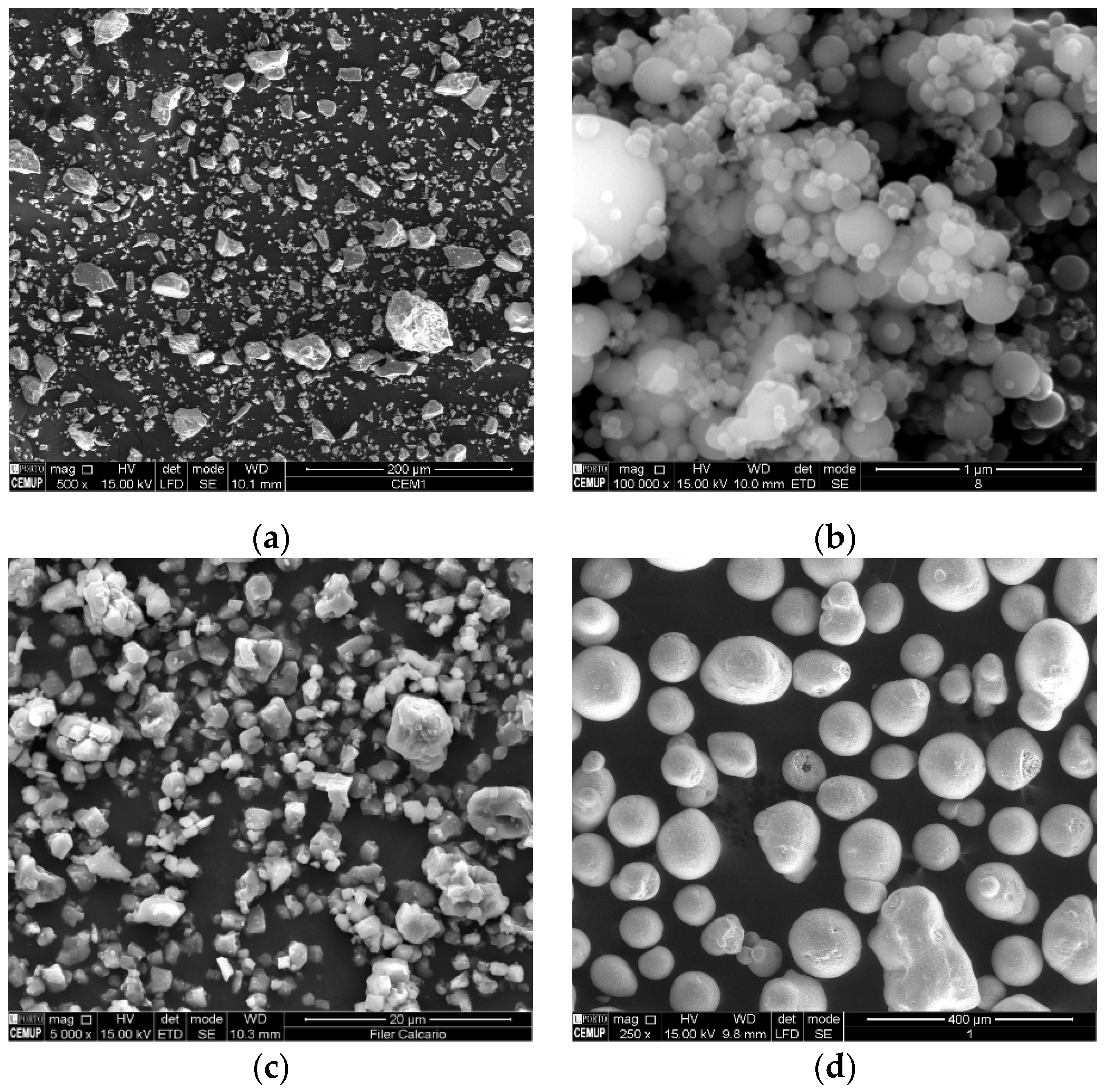


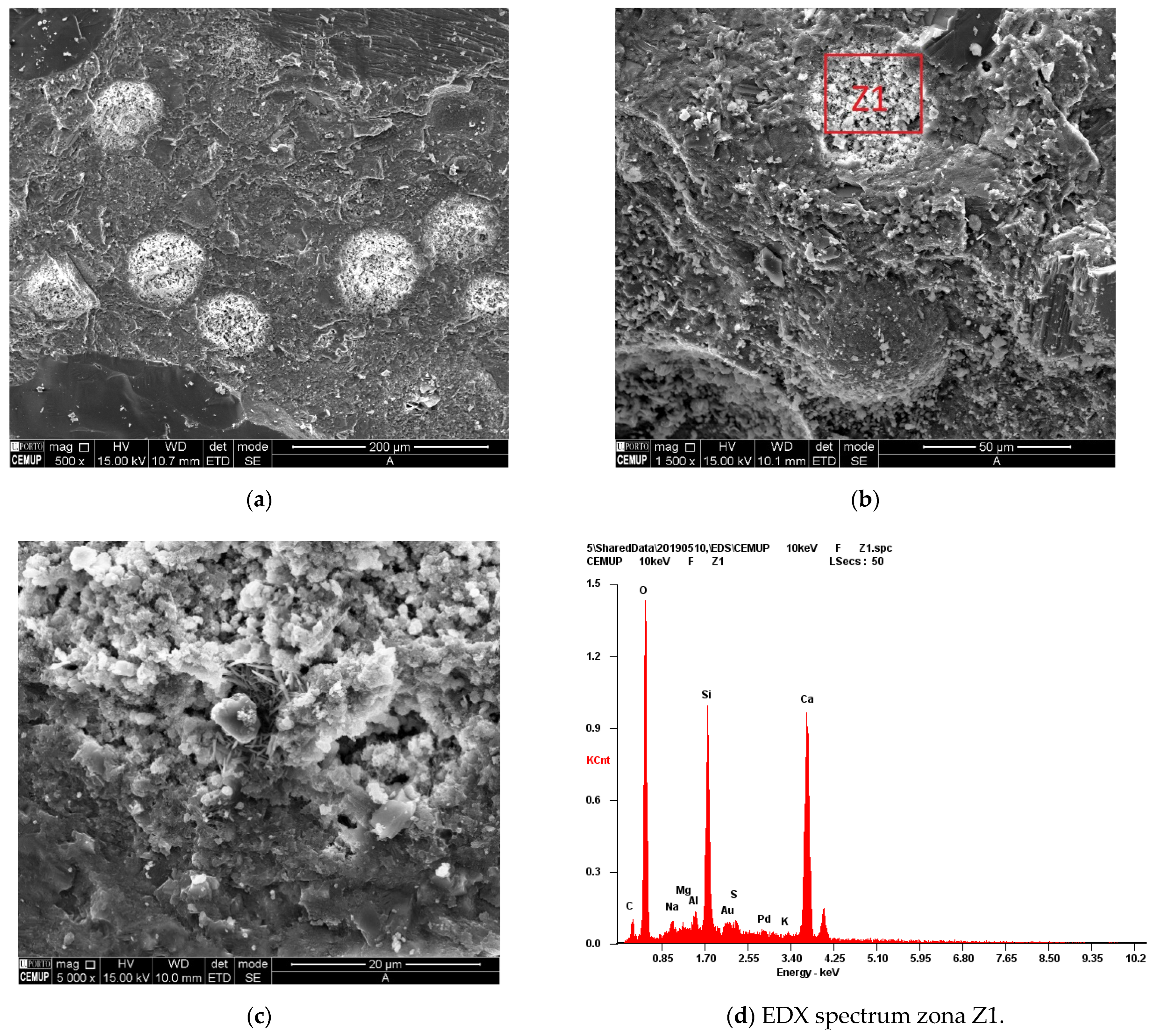
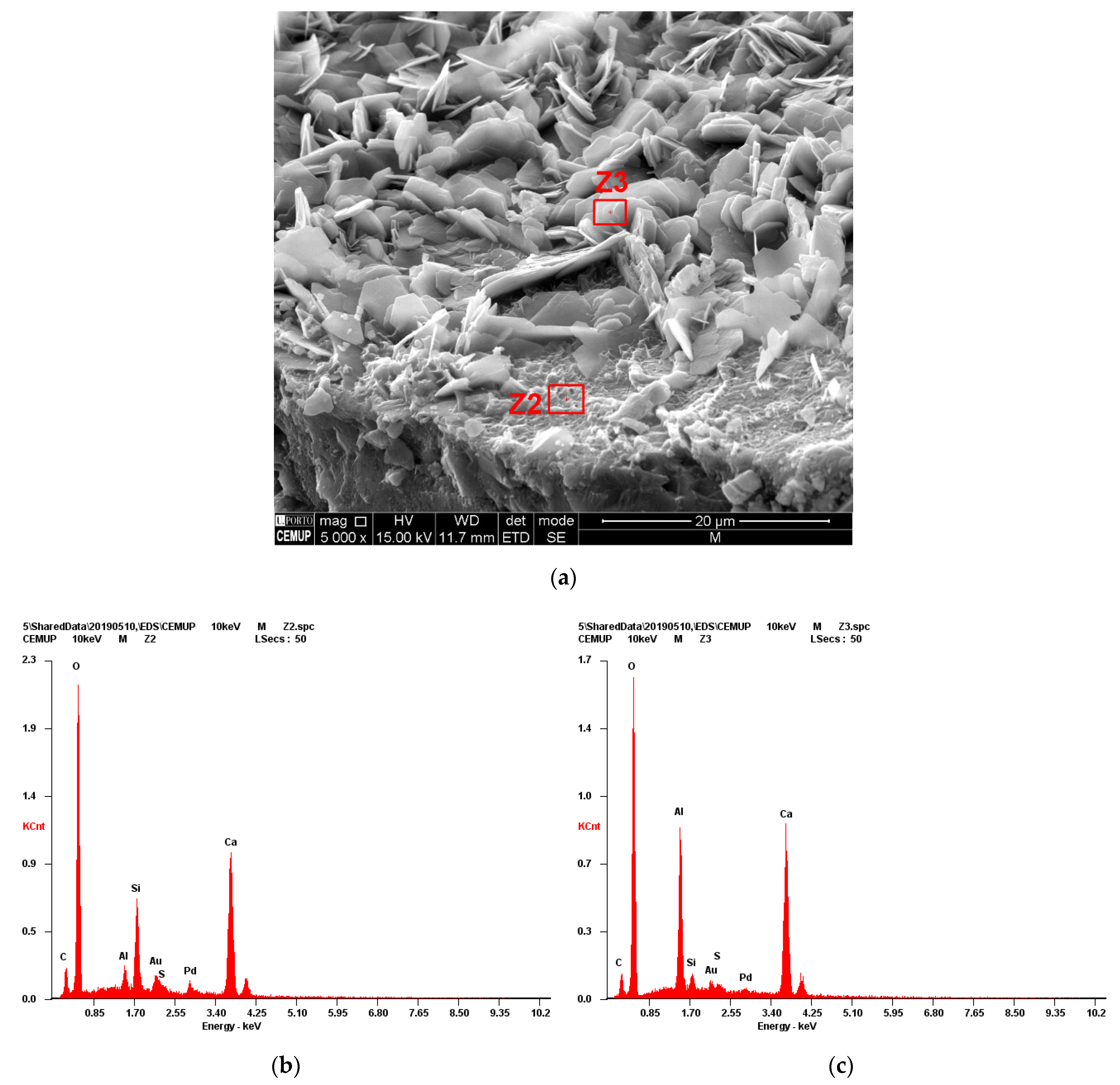
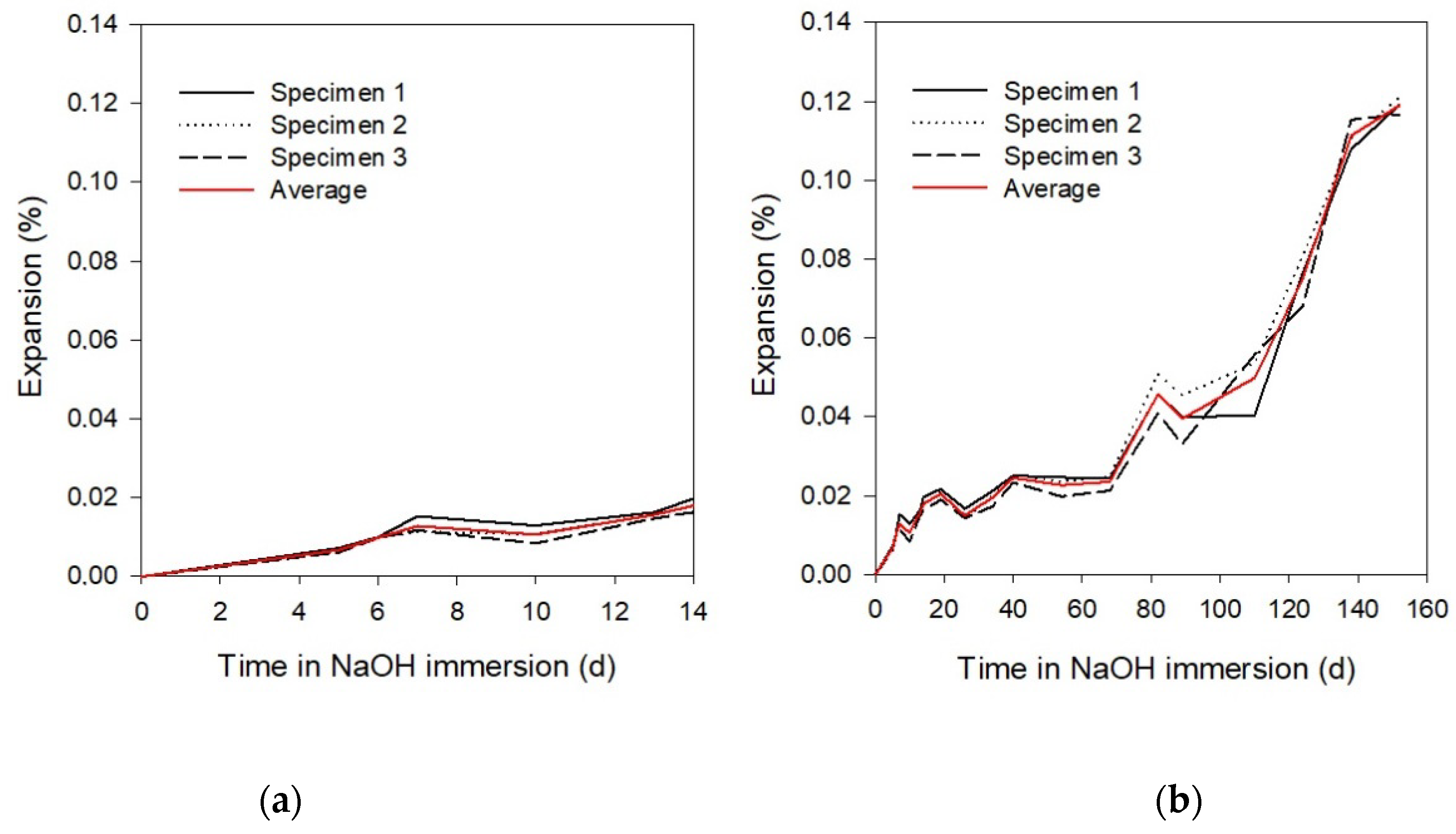
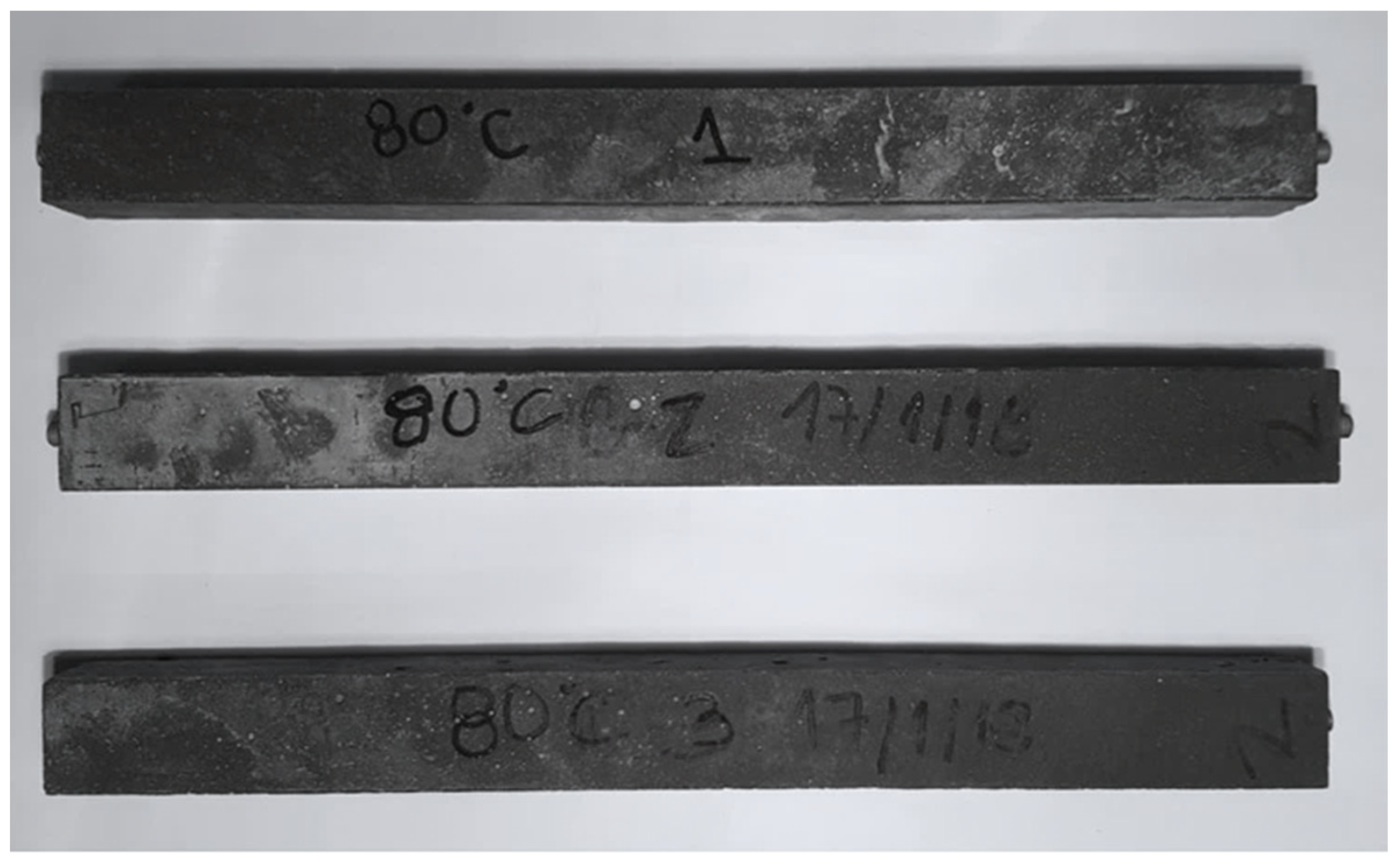

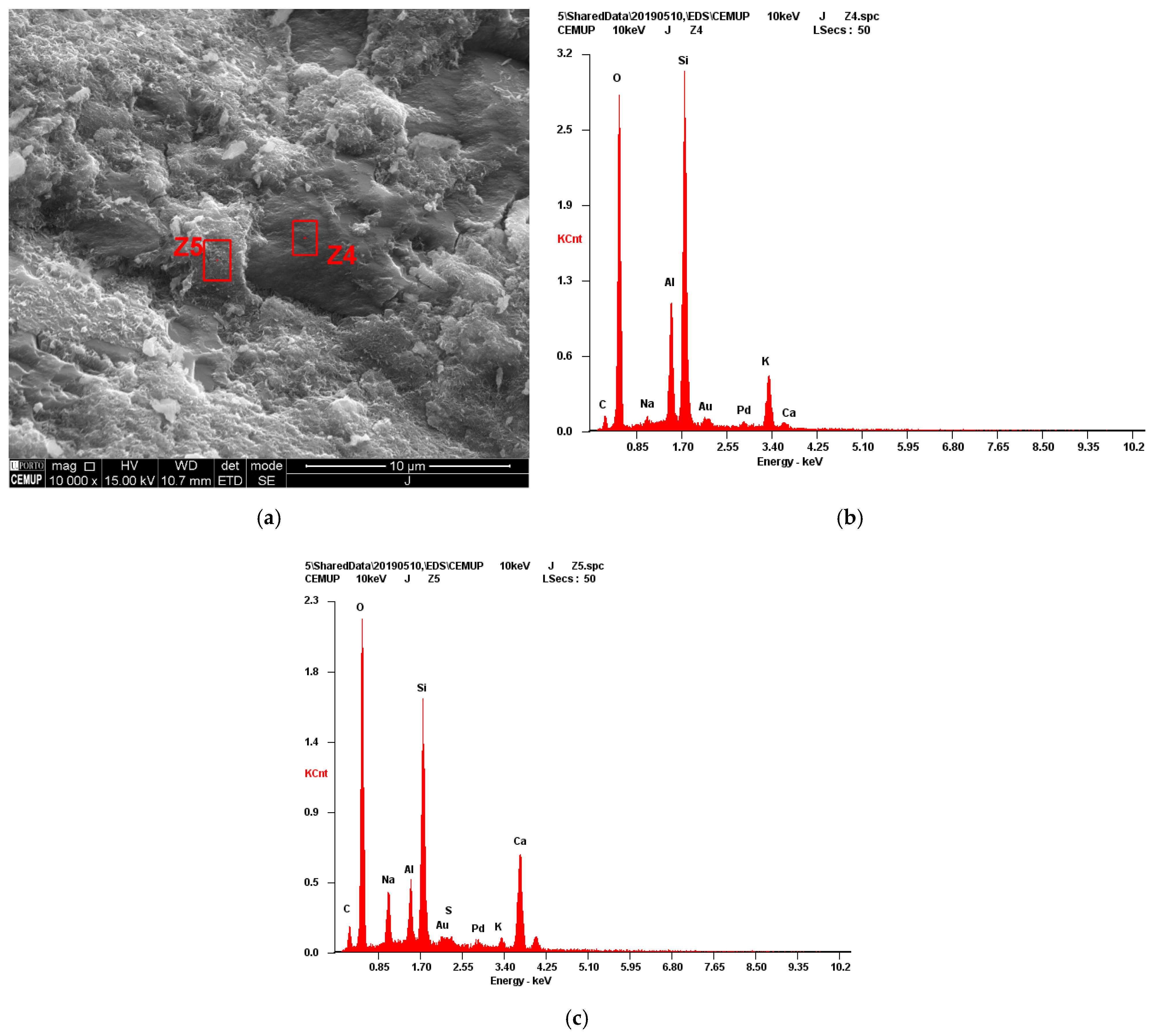

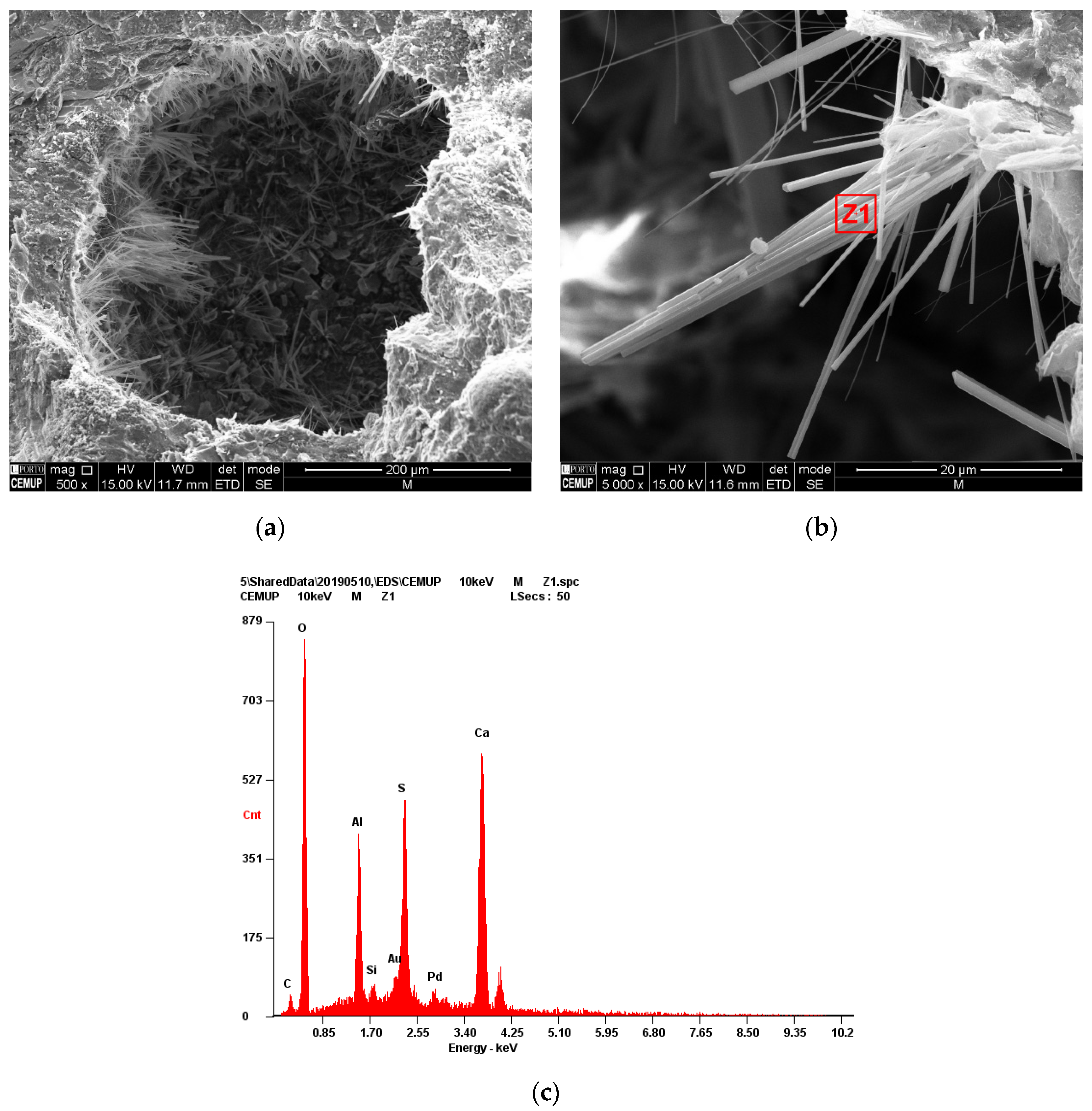
| Cement | SF | LF | ECat | ||
|---|---|---|---|---|---|
| Main oxide composition (%) | SiO2 | 19.80 | >90 | 40.30 | |
| CaO | 61.32 | 99.0 | 0.06 | ||
| Fe2O3 | 3.16 | 0.02 | 0.45 | ||
| Na2O | 0.15 | 0.43 | |||
| Al2O3 | 5.08 | 54.45 | |||
| MgO | 1.82 | 0.15 | |||
| K2O | 0.58 | 0.02 | |||
| SO3 | 2.90 | 0.00 | |||
| LOI (%) | 2.54 | 1.05 | |||
| Pozzolanic activity (NF P18−513) | mg Ca(OH)2/g | 1577 | 1540 | ||
| Physical properties | Density (kg/m3) | 3310 | 2200 | 2680 | 2660 |
| Specific surface (m2/kg) | 440 | 19632 | 550 | 150,070 | |
| Initial setting time (min) | 141 | ||||
| Final setting time (min) | 201 | ||||
| D10 (μm) | 1.40 | 0.11 | 1.12 | 50.00 | |
| D50 (μm) | 10.00 | 0.32 | 4.55 | 90.00 | |
| D90 (μm) | 25.00 | 0.84 | 15.36 | 120.00 | |
| Mechanical properties | Rc,2 (MPa) | 32.20 | |||
| Rc,7 (MPa) | 47.40 | ||||
| Rc,28 (MPa) | 60.80 | ||||
| Raw Materials | UHPC (kg/m3) | |
|---|---|---|
| Binder phase | Cement | 690.19 |
| Silica fume | 33.56 | |
| Limestone filler | 250.58 | |
| Aggregates | ECat | 155.45 |
| Siliceous sand | 852.11 | |
| Admixture | Superplasticizer | 19.49 |
| Water | Mixing water | 160.86 |
| ECat’s absorption water | 46.64 |
| Scale | Property | Test Standard/Technique | Curing Regime | Age at Testing | Number of Specimens | Specimens Geometry and Size |
|---|---|---|---|---|---|---|
| Macro | Porosity | Section 2.2.1 | Water curing, 20 °C | 28 days | 1 | Cylindrical h = 30 mm, Ø = 9 mm |
| ASR | ASTM C 1260 Section 2.2.2 | ASTM C 1260 | up to 184 days | 3 | Prismatic 25 × 25 × 250 mm3 | |
| External sulphate attack | LNEC E−462 Section 2.2.3 | LNEC E−462 | up to 26 weeks | 6 | Prismatic 20 × 20 × 160 mm3 | |
| Micro | Microstrucutre | SEM Section 2.2.4 | Water curing, 20 °C | 28 days | 3 | |
| ASR | SEM Section 2.2.4 | 80 °C, 1N NaOH | 184 days | 3 | ||
| External sulphate attack | SEM Section 2.2.4 | 20 °C, sodium sulphate | 26 weeks | 3 |
| Time (d) | Average | Std Dev | Average | Std Dev | |
|---|---|---|---|---|---|
| 0 | 0 | 0 | 0 | 0 | 0 |
| 14 | −0.0001 | 0.0001 | −0.0006 | 0.0000 | −0.0005 |
| 28 | −0.0035 | 0.0001 | −0.0033 | 0.0000 | 0.0002 |
| 42 | −0.0023 | 0.0001 | −0.0022 | 0.0002 | 0.0001 |
| 70 | −0.0027 | 0.0002 | −0.0025 | 0.0000 | 0.0002 |
| 84 | −0.0022 | 0.0005 | −0.0064 | 0.0005 | −0.0025 |
| 98 | −0.0029 | 0.0003 | −0.0030 | 0.0001 | −0.0000 |
| 112 | −0.0024 | 0.0002 | −0.0041 | 0.0030 | −0.0017 |
| 126 | −0.0069 | 0.0005 | −0.0055 | 0.0002 | 0.0014 |
Publisher’s Note: MDPI stays neutral with regard to jurisdictional claims in published maps and institutional affiliations. |
© 2022 by the author. Licensee MDPI, Basel, Switzerland. This article is an open access article distributed under the terms and conditions of the Creative Commons Attribution (CC BY) license (https://creativecommons.org/licenses/by/4.0/).
Share and Cite
Matos, A.M. Susceptibility to Expansive Reactions of a Greener UHPC: Micro to Macro-Scale Study. Appl. Sci. 2022, 12, 6252. https://doi.org/10.3390/app12126252
Matos AM. Susceptibility to Expansive Reactions of a Greener UHPC: Micro to Macro-Scale Study. Applied Sciences. 2022; 12(12):6252. https://doi.org/10.3390/app12126252
Chicago/Turabian StyleMatos, Ana Mafalda. 2022. "Susceptibility to Expansive Reactions of a Greener UHPC: Micro to Macro-Scale Study" Applied Sciences 12, no. 12: 6252. https://doi.org/10.3390/app12126252
APA StyleMatos, A. M. (2022). Susceptibility to Expansive Reactions of a Greener UHPC: Micro to Macro-Scale Study. Applied Sciences, 12(12), 6252. https://doi.org/10.3390/app12126252






